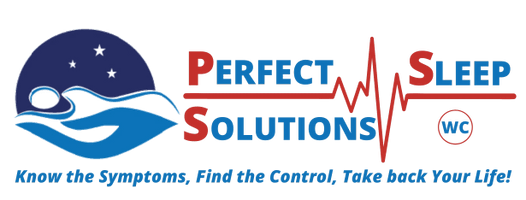TROUBLE-SHOOTING GUIDE
Getting used to the CPAP mask
(One of the most common problems is getting comfortable wearing a CPAP mask. Inconsistently using the mask may delay getting used to it).
- Start by using your mask during the day or at night before bedtime while watching TV, reading or listening to music.
- Stick with it for several weeks to see if the mask and pressure settings selected for you will work.
Leakage around mask
- Tighten the headgear.
- Loosen the headgear.
- Change angle of mask.
- Contact your Perfect Sleep Solutions Clinician to try a different size of mask.
- Change the position of your pillow so that the mask hangs over the edge and is not being pushed by the pillow.
- Adjust the position of the hose so that it is not pulling on the mask and causing it to leak.
Breathing out is difficult
- There is a resistance to breathing out which is a normal feeling when first starting on CPAP – this pressure is what splints the airway open. It takes some time to get used to the feeling.
- You may be able to overcome this by using a RAMP feature in your machine.
Dry mouth or sore throat in the morning
- Adjust the humidity setting on your CPAP machine – this will relieve dryness.
- Try using a chin strap if your mouth keeps opening during the night.
Difficulty falling asleep
- Start by using your mask during the day or at night before bedtime while watching TV, reading or listening to music.
- First try the acclimation period mentioned above.
- Avoid stimulants such as caffeine, nicotine or chocolate at least four hours before going to bed.
- Keep a consistent schedule or sleep routine.
Congested nose or runny nose
- A stuffy nose during the first few weeks of being on CPAP is quite common. Nasal irritation can be due to the air pressure being delivered through the mask. This should subside after the first week of therapy.
- Be sure your CPAP machine has a humidifier and that it is working properly.
- Try using saline nasal spray or water-based lubricant to help moisten the nasal passages.
- Contact your doctor if nasal dryness or stuffiness persists. Request a nasal steroid.
- If nasal congestion is not an issue, you may contact your Perfect Sleep Solutions Clinician to check your therapy pressure.
Removing the mask during the night
(It’s normal to sometimes wake up to find that you’ve removed the mask in your sleep).
- You may be pulling the mask off because of congestion. Refer back to the solution for nasal congestion.
- Ensure that the humidifier is working correctly.
- You may have to adjust the settings.
- Try a chin strap. Remember, getting used to CPAP therapy is a gradual process.
Stomach bloating or gas
(This is because of swallowing air).
- Wear a chin strap to prevent the swallowing of air.
- Raise the head of your bed slightly.
- Try to sleep on your side.
- Contact your Perfect Sleep Solutions Clinician if you continue to have problems.
Irritation of the eyes
- Ensure that your mask is properly adjusted and not leaking before you go to sleep.
- Use a special pillow designed for CPAP to reduce the chance of mask moving.
Sores on the nose from mask
- Loosen the headgear – the mask may be too tight.
- Apply a Band-Aid to reddened area so that it does not develop into an open sore.
- Contact your Perfect Sleep Solutions Clinician to try a different mask that puts less pressure on the sore area.
My spouse tells me that I am snoring again
- If your CPAP machine is set on Auto CPAP mode, snoring may occur at the lower pressures until it increases to your ideal pressure. This occasional snoring at the start of the night is normal.
- If you are snoring through the entire night, your pressure may be set too low. Contact your Perfect Sleep Solutions Clinician.
Air flow is low
- Check for leaks in the tubing and where it connects to the humidifier.
Air flow is too cold
- Increase temperature setting.
- Place the hose under your blankets.
- Insulate the hose.
Time and patience are the keys to success!
Using a CPAP device can be frustrating as you try to get used to it. But it is important that you stick with it. The treatment is essential to avoiding obstructive sleep apnea related complications such as heart problems and daytime fatigue. Work with your doctor and CPAP supplier to ensure the best fit and device for you. Try making adjustments if you’re experiencing some of the common CPAP problems. It may take several weeks or even months to find the correct settings for you and to adapt to wearing a mask while you sleep. With time and patience, CPAP can positively affect your quality of life and health.
